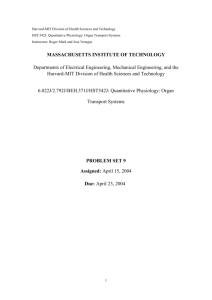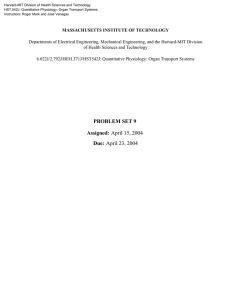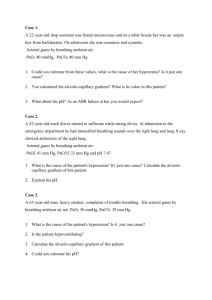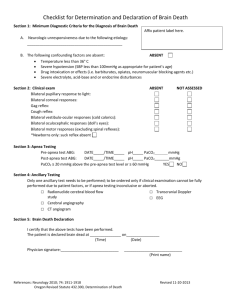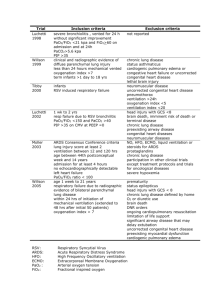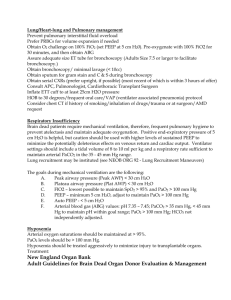Harvard-MIT Division of Health Sciences and Technology
advertisement
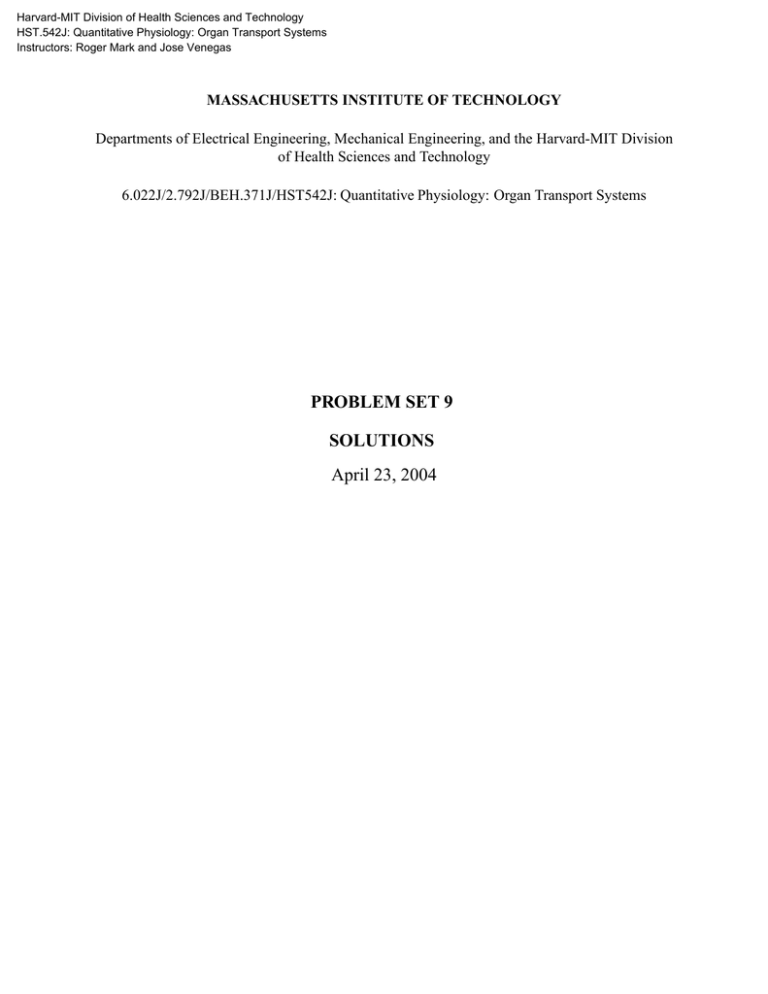
Harvard-MIT Division of Health Sciences and Technology HST.542J: Quantitative Physiology: Organ Transport Systems Instructors: Roger Mark and Jose Venegas MASSACHUSETTS INSTITUTE OF TECHNOLOGY Departments of Electrical Engineering, Mechanical Engineering, and the Harvard-MIT Division of Health Sciences and Technology 6.022J/2.792J/BEH.371J/HST542J: Quantitative Physiology: Organ Transport Systems PROBLEM SET 9 SOLUTIONS April 23, 2004 Problem 1 Emphysema is one of the leading causes of death in the United States. Our ability to treat emphy­ sema is severely limited because the principal physiologic deficiency results from the destruction of the architecture of the lung. The development of lung transplantation was the first direct ap­ proach to the treatment of advanced emphysema. However, most patients with severe disease are precluded from undergoing this surgery by advanced age and coexisting conditions. Lung-reduction surgery is the newest therapeutic option for patients with emphysema and one that is potentially available to many more patients. The idea of removing 25 percent or more of the lung from a patient with marginal lung function appears, to say the least, counterintuitive. Nevertheless, in certain patients with emphysema, lung-reduction surgery can result in substantial lessening of dyspnea and improved overall function and quality of life for up to a year after surgery. A. First, draw the normal chest wall and lung compliance curves. Then, draw the changes that result from emphysema, which increases compliance of the lungs. Assume that the chest wall doesn’t change. What happens to FRC with emphysema? B. Second, draw the effects of removing 25 percent of lung tissue. What happens to the amount of pressure and work required to inspire a similar tidal volume? In emphysema, the increase in compliance leads to a steeper lung compliance curve, and FRC will increase. This leads the respiratory system to function on the high part of the pressure-volume curve, which requires more work to inspire a given tidal volume, even though lung compliance has increased. Removing 25 The emphysematous destruction of lung tissue causes a loss of elastic recoil. This loss of recoil has several important consequences. First, airways tethered to lung parenchyma lose their support; thus, their diameter at any specific lung volume is reduced. This mechanism contributes to the increase in specific airway resistance and reduced maximal expiratory flow. Second, the volume at which lungs and chest cavity operate increases because the outward recoil of the chest wall is opposed to a lesser extent by the inward recoil of the lungs and because reduced expiratory flows cause dynamic hyperinflation. Operating at high volumes not only places the inspiratory muscles at a mechanical disadvantage but also increases their elastic load from inadvertent positive endexpiratory pressure. Compounding the mechanical consequences of emphysema is the impaired gas exchange function of the lung. The success of lung reduction surgery implies that these patients were limited by mechanical constraints on the respiratory system. Of note, the loss of gas exchange surface from lung re­ section does not aggravate the problem, a further emphasis of the intimate relationship between mechanical impairment and gas exchange function. 2004/538 6.022j—2004: Solutions to Problem Set 9 2 emphysema 100 normal 80 normal Che st W all 60 Lu & 20 FRC in emphysema L ung 40 ng Vital Capacity (%) CW normal FRC 0 –20 –10 0 10 20 30 Pressure (cm H2O) 3 6.022j—2004: Solutions to Problem Set 9 Problem 2 Alveolar-Arterial Oxygen Pressure Difference The normal PaO2 is age-dependent, declining slightly over the years. This decline reflects shifts in ventilation/perfusion (V /Q) ratios in the aging lung. In contrast, alveolar partial pressure of oxy­ gen ( PAO2 ) depends only on the pressure of inspired oxygen ( PIO2 ), respiratory quotient (R), and alveolar partial pressure of carbon dioxide ( PACO2 ). Since none of these values is age-dependent, PAO2 does not change as we age. The horizontal line in Figure 1 below shows normal PAO2 breath­ ing ambient air (FIO2 = 0.21) at sea level; the difference between the diagonal band and the horizontal PAO2 line is the alveolar-arterial oxygen pressure difference P(A−a)O2 . Note that normal P(A−a)O2 breathing ambient air can reach approximately 30 mmHg in elderly people. Figure 1: 2 PO (mmHg) PAO 2 100 90 80 70 60 50 40 30 20 10 PaO 20 30 40 2 50 60 70 80 Age (yrs.) Changes in PaO2 and P(A−a)O2 with age. The line for PaO2 is based on the regression equation, PaO2 = 109 − 0.43 (age in years), PaO2 , measured at PB 760 mmHg. (From Sorbini, C.A., Grassi, V., Solinas, E., et al.: Respiration 25:3, 1968.) A. Based on the above graphs: A 35-year-old patient has a PaO2 of 90 mmHg. Are his lungs working properly to transfer oxygen? Is more information needed? More information is needed, namely PaCO2 or PACO2 , to calculate PAO2 . (And, you’d have to know that he was inspiring room air.) B. A 45-year-old patient has an arterial PO2 at sea level of 85 mmHg. For each of the following FIO2 and PaCO2 values, state if his lungs are transferring oxygen properly. Assume R = 0.8. (i) FIO2 = 0.21, PaCO2 = 25 mmHg 25 PACO2 = (760 − 47) · 0.21 − = 118 mmHg R 0.8 = 118 − 85 = 33.5 mmHg PAO2 = PIO2 − P(A−a)O2 Abnormal 6.022j—2004: Solutions to Problem Set 9 4 Figure 2: 120 +2 SD P(A-a)O2 (mmHg) 100 80 +1 SD 60 Mean 40 –1 SD 20 –2 SD 0 0.2 0.4 0.6 0.8 1.0 FIO2 Normal range of P(A−a)O2 from FIO2 of 0.21 to 1.00, based on data obtained from 16 healthy subjects aged 40 to 50 years. Lines represent mean values and + or – 2 SD (standard deviations). The P(A−a)O2 increases up to 0.6 and then plateaus with increasing FIO2 . Note that P(A−a)O2 may exceed 100 mmHg on an FIO2 of 1.00 in “normal” people. Similarly, (ii) FIO2 = 0.21, PaCO2 = 40 mmHg PACO2 40 = (760 − 47) · 0.21 − = 99.7 mmHg R 0.8 = 99.7 − 85 = 14.7 mmHg PAO2 = PIO2 − P(A−a)O2 Borderline to abnormal (+2SD) (iii) FIO2 = 0.21, PaCO2 = 50 mmHg 50 PACO2 = (760 − 47) · 0.21 − = 87.2 mmHg R 0.8 = 87.2 − 85 = 2.2 mmHg PAO2 = PIO2 − P(A−a)O2 Normal (iv) FIO2 = 0.40, PaCO2 = 30 mmHg PACO2 30 = (760 − 47) · 0.21 − = 247.7 mmHg R 0.8 = 247.7 − 85 = 162.7 mmHg PAO2 = PIO2 − P(A−a)O2 Abnormally high (> 2SD from mean) 5 6.022j—2004: Solutions to Problem Set 9 C. Which of the following are potential causes of increased P(A−a)O2 in a patient who is healthy except for the indicated physiologic condition? � � (i) Thickening of alveolar-capillary membrane � � (ii) Elevated PaCO2 � � (iii) Ventilation-perfusion imbalance � � (iv) Anemia � � � � (v) Right-to-left intrapulmonary shunting � � (vi) Right-to-left intracardiac shunting � � (vii) High altitude (viii) Carbon monoxide inhalation Potential causes of increased P(A−a)O2 : Thickening of alveolar-capillary membrane. Ventilation-Perfusion imbalance. Right-to-left intrapulmonary shunting. Right-to-left intracardiac shunting. Note: Anemia and carbon monoxide poisoning will decrease oxygen content of the blood, but the PO2 will not be changed. 2004/539 6.022j—2004: Solutions to Problem Set 9 6 Problem 3 A drunk driver strikes a sidewalk victim. The victim has pain in his chest and is taken to an intensive care unit. Measurements are made through catheters: Hemoglobin: 14 gm/100 ml Superior vena cava and inferior vena cava blood saturation: 52 Right atrium blood saturation: 52 Right ventricle blood saturation: 77 Pulmonary artery blood saturation: 77 Systemic arterial blood saturation: 98 Pulmonary capillary blood saturation: 99 Oxygen consumption: 200 ml/min Calculate the shunt in this case. Explain where it is located and the direction. Remember that hemoglobin carries 1.36 ml oxygen/gm Hb. You may neglect the dissolved oxygen in the blood. Shunt is between the ventricles (L → R) since there is a step up in O2 content going from RA → RV. Please note, Q P designates the flow through the lungs that undergoes gas exchange, and Q S designates flow through the body that exchanges oxygen with the tissues. It is possible to have some right-to-left shunt that passes through the pulmonary circulation (for example, when an airway is obstructed) that would not be included in Q P . QP = ml 200 min O2 consumption = CPVO2 − CPAO2 (0.98 − 0.77)(14 100 gmlHb blood )(10)(1.36 ml O2 g Hb ) ⇒ Q P = 4.5 L/min ml 200 min O2 consumption QS = = CaO2 − CRAO2 (0.98 − 0.52)(14)(10)(1.36) ⇒ Q shunt = Q P − Q S = 4.5 − 2.3 = 2.2 L/min 2004/540 7 6.022j—2004: Solutions to Problem Set 9
